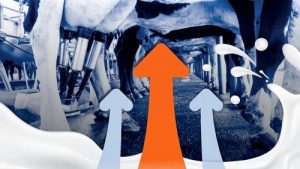
May milk production at 18.8 billion pounds was down 1.1% year over year from almost 19.1 billion pounds in 2019, according to USDA National Agricultural Statistic Service.
“Some of the dairy co-ops put in base excess plans, etc. It appears that has taken effect,” Bob Cropp, University of Wisconsin dairy economist, said in the latest “Dairy Situation and Outlook” podcast.
Cow numbers in May were down 11,000 head from April and 15,000 head from March but were still 35,000 head above a year ago.
“But there was a big drop in milk production per cow,” he said.
Per-cow production dropped 31 pounds and 1.5% year over year.
“Definitely farmers have responded, reducing milk production — which is a factor we’re seeing in milk prices changes right now,” he said.
The Class III milk price, which was $17.05 a hundredweight in January, dropped to $12.14 in May. But the June price is looking like it’ll be $20 with a record increase from one month to the next, he said.
Lower milk production, government purchases, restaurants slowly opening up and restocking foodservice inventories were all factors, he said.
“It shows how sensitive this market is to relatively small changes, but that tightened things up,” he said.
The cash cheese price for 40-pound blocks went from $1 a pound two months ago to $2.50 on Friday, Mark Stephenson, fellow dairy economist at the university, said.
The big question is how long the higher prices will stay, Cropp said.
The futures market jumped, with July Class III prices above $20. They trail off to the high $16 by the end of the year, he said.
There’s a lot of uncertainty as to where prices will go. Milk production will be going down seasonally with the hot summer months. Restaurants are opening, and processors will be building inventory for holiday demand.
“We could see those prices at least in the next quarter holding pretty good, he said.
The big question is whether farmers will continue to hold down milk production. The other question is whether there’ll be another coronavirus outbreak that slows things down again, he said.
While 14 of the 24 reporting states decreased milk production year over year — including a 1.5% decline in California and a 3.1% decline in Wisconsin — milk flowed strong in others. May milk production was up in seven states, including gains of 4.8% in Idaho, 4.6% in Colorado and 9.7% in South Dakota.
“Farms are starting to react to these higher prices, at least in the West,” Stephenson said.
Values for springers out there are higher than they’ve been in many years, he said.
“This is just kind of telling you that these guys want to make milk if the prices are going to be here. That’s going to kill the golden goose if they’re going to start making a lot of milk,” he said.
























